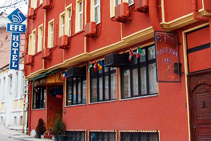
Address: Maarif Caddesi, No 13, Edirne / TURKEY
Phone: +90 (284) 213 61 66
Fax: +90 (284) 213 60 80
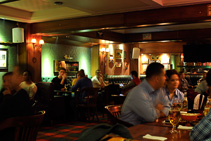
Address: Maarif Caddesi, No 13 Ak Efe Hotel Edirne / TURKEY
Phone: +90 (284) 213 16 88

Address: Mithatpaşa Mah.Aziziye Sokak, No:5 Edirne / TURKEY
Phone: +90 (284) 225 67 67

Wedged between 3 empires of civilization through aces, Edirne is the crossroads of various historical and cultural trends. The capital city of the Ottoman Empire between 1357-1453, Edirne has a broad spectrum of the Ottoman architecture..
The city was founded by the Roman Emperor Hadrian and has since witnessed many battles and migrations. The city is rich with Ottoman monuments such as mosques, caravansaray and market places.

This event's somewhat kinky title belies the fact that it is a sport that is over five centuries old. Oil-coated wrestling or Yagli Gures was devised as a means of training troops, but it has since become a popular spectacle, with champions becoming national celebrities.
Wearing only a pair of leather trousers and a good slick of olive oil, competitors pair off and struggle to gain a grip on their opponent, before one is flipped over and pinned to the ground. The winner goes on to fight another winner, and so on, until there is only one wrestler left standing. The whole tournament can take days.
Combat aside, the festival also attracts gypsies from around the Middle East and Eastern Europe. A colourful fair springs up outside the arena, and visitors tired of cheering and booing fighters can come and lose themselves in the sights and sounds of the Bohemian way of life.

This mosque is the oldest Ottoman monument in Edirne. Construction was begun by Emir Süleyman in 1403 and completed during reign of Çelebi Sultan Mehmet in 1414. It was designed by architecht Hacı Alaaddin from Konya and built by Ömer İbn İbrahim. It has many domes after the "Grand Mosque" (Ulu Camii) style. The marble gate decorative inscriptions inside are arresting.
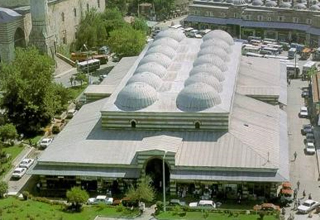
Between 1417 and 1418 Sultan Mehmed I Çelebi founded a bedesten as an endowment for Eski Mosque. Built by Mimar Alaeddin, this 14 domed building consisted of a row of shops around the outside and 36 vaulted rooms inside. Its walls were of red and white ashlar stone.

Üç Şerefeli Mosque, built between 1438 and 1447 by Mural I, presages the great period of Ottoman mosque architecture under Sinan and embodies both a new freedom from restraint and advances in engineering. The northwest minaret has three galleries, hence the mosque's name and was the highest minaret until those of the Selimiye Mosque eclipsed it.

Most of the artifacts in the collection are prehistoric. There are also Greek, Roman and Byzantine artifacts including a fine collection of gold, silver and bronze coins, statues and earthenware and glass vases. Ethnographic part has Ottoman household goods and furniture, rugs, kilims, coins, dresses and clothing.

The museum was opened in the Koranic College Medrese of Selimiye Mosque in 1925. It was reorganised in 1971. In the entrance gallery of the museum are stone inscriptions from the Ottoman period taken from buildings that are no longer standing, such as mosques, caravanserais, hamams (Turkish baths), drinking fountains etc. Also there are Ottoman period tiles, hand written copies of the Holy Koran, embroidery, weapons and glass objects.
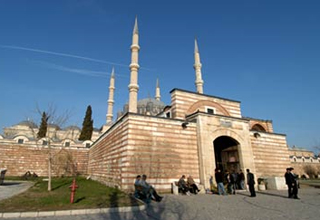
This mosque was built between 1569 and 1575 by Mimar Sirıan for Sultan Selim II, and Mimar Sinan described it as his masterpiece. It has four minarets, each with three balconies, and these graceful minarets set at each corner around the central dome are visible from a great distance outside the city.
The 31.5 metre diameter dome rests on eight pillars set back against the walls, so creating an unbroken soaring central space. The eloquent unity of the interior, visible in entirety at a glance, is remarkable. The clear silhouette of the exterior is dominated by the dome.
Selimiye Mosque is also celebrated for the perfection of its marble carving, tiles and calligraphic decoration. In particular the marble carving of the minber has never been surpassed. The mihrap wall, royal gallery and the pediments of all the lower course windows are decorated with beautiful tiling, the finest in colour and composition being the large tile panels on the mihrap wall. The stencil decoration on the ceiling of the lower part of the royal gallery is also of especial note.
An intricately carved marble şadırvan stands in the cloistered couriyard.
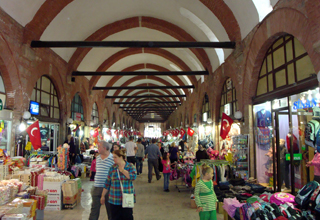
The Arasta (shopping area) was intended to provide revenue for the mosque. Although the architect is known to have been Davud Agha, some scholars believe, on the basis of the location of the building and its connection with the plan of the mosque, that the design was based on a design drawn up by Mimar Sinan just before his death. It is composed of a long branch extending 225 m along the whole length of the western wall of the mosque courtyard and a short branch perpendicular to this. The short branch is located on the axis of the side entrances to the shadirvan courtyard. The point of intersection of the branches is marked by a dome resting on a high drum effecting the transition to the courtyard.
Bahai house which is the one of the four house that Hz. Bahaullah has lived. It is also sacred for Bahai citizens. Therefore, most of the Bahais come to Edirne for visiting this house.

It is constructed in 1880 at Kıyık district of Edirne. Writings at the church, decorated in 1889, are written with Slav Bulgarian Language. There are some pictures remaining from the former church which was at the same place before. Today the structure has still been well-kept.

The memorial and museum were built in commemoration of these who had been killed during the Balkan War which broke on 26 March 1913. Şükrü Paşa had defended Edirne during the war. His grave was moved to Kıyık Tabya near Edirne, and a memorial erected in his honor. The museum contains objects relating to the Balkan War.

The Museum is in part of a historical, cultural and religious complex built in 1484-1488 by Sultan Bayezid II, the 8th Ottoman Emperor. The complex was particularly noted for its work in the field of medicine: students studied medicine, patients were treated and the poor received food.
In due course the hospital concentrated on treating people with mental disorders, employing holistic treatments, using the sound of water, music and aromatic compounds made from flowers as well as more traditional methods.
After years of neglect from the end of the 19th century, parts of the complex have been restored by Trakya University. These parts include the kitchen, laundry and asylum for the insane. Visitors has a chance to listen musiki music and sounds of water which has been used to calm mentally disordered patients several centuries ago.
The museum of health in the Sultan Bayezid II Complex has been awarded the council of europe museum prize in 2004.
This fine picnic area is situated between two branches of the Tunca River. The region, which includes the Hen Forest, is densely covered with rees. Transportation across the rivers is provided by Kanuni Süleyman Bridge to the east and by Fatih Bridge to the west. Each year the Kırkpınar Grease Wrestling and Cultural activities are held here, attracting many locals and foreigners.
Adalet Kasrı was built by order of Kanuni Sultan Süleyman to Mimar Sinan in 1561. It is four stories hign, including the ground floor, with a marble fountain and pool on the top floor.
Over 300.000 civillian and military soldiers gave their lives defending their beloved homeland between 1912-1913 in Balkan Wars. This Memorial honors 20.000 soldiers who were left to starve in Sarayiçi.
Mosque has rich decorative with door and windows. Hamam which was built by Gazi Mihal is today not available for worship.

It is at Kaleiçi district of Edirne, and constructed on 1902 - 1903. Today it was not available for worship.
It is firstly built madrasa by Murat II. After it was changed to mosque. It was damaged in Bulgarian distraction in 1913. The sons of Murat II, Mustafa II and the daughters of Ahmet III. graves are in Dar-ül Hadis tomb.

It is constructed on a Sarayiçi reigning hill at Muradiye district by Murat II. There is no dating on its inscription. It is the most beautiful sample of the side spaced (with zaviye) mosques. In spite of simplicity of external appearance, mosque is one of the most drawing attention structures of 15th century Ottoman art according to internal adornment. Niche and walls covering tiles, are the most beautiful samples of the Turkish tile art.
The city was founded by Roman Empire Hadrianus and surrounded by ramparts and 4 towers. The only remaining one, Macedonia Tower and its environs is opened to visit as Urban Archeology Park after the excavation.
To find out detailed info about Edirne in Turkish Edirneden.com